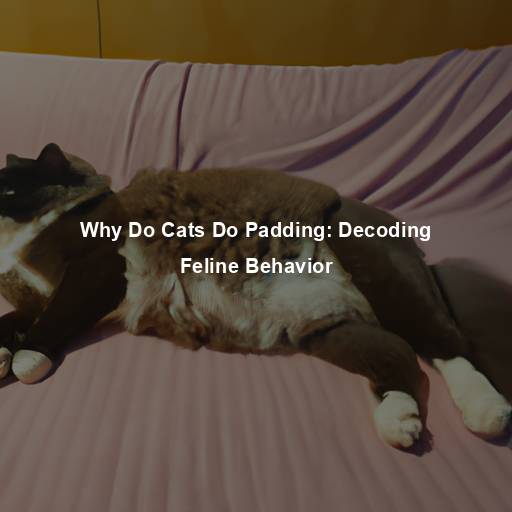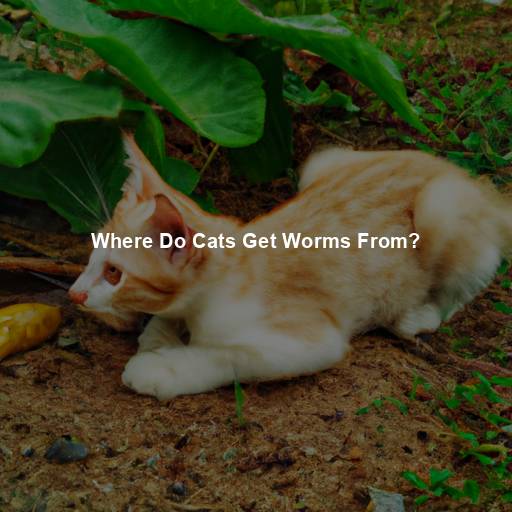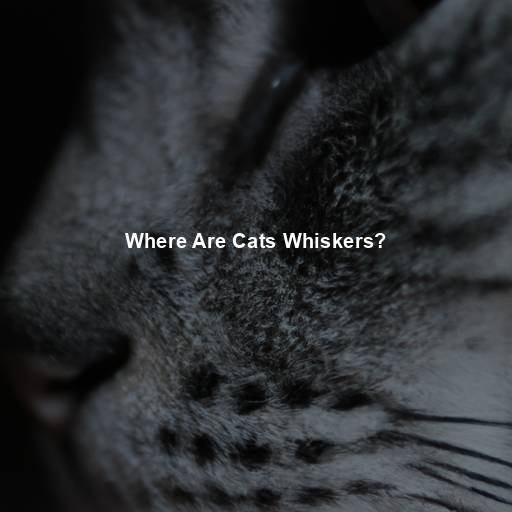Why Do Cats Do Padding: Decoding Feline Behavior
Last Updated on July 23, 2023 by Evan
Contents [hide]
- 1 Understanding the Intricate World of Cats
- 1.1 The Origins of Padding: Instincts from the Wild
- 1.2 An Expression of Contentment and Happiness
- 1.3 Territory Marking and Scent Communication
- 1.4 A Relic of Comfort from Kittenhood
- 1.5 Marking You as Part of Their “Clan”
- 1.6 Relieving Stress and Anxiety
- 1.7 Understanding the Paw Pads: A Cat’s Tactile Sensitivity
- 1.8 The Role of Endorphins: A Natural High
- 1.9 The Influence of Genetics and Breed
- 1.10 The Impact of Early Socialization
- 1.11 Addressing Concerns: Is Padding Always Harmless?
- 1.12 A Symbol of Trust and Security
- 1.13 Building Stronger Bonds Through Interactive Play
- 1.14 The Power of Positive Reinforcement: Rewarding Desirable Behavior
- 1.15 Addressing Inappropriate Padding: Redirecting Behaviors
- 2 Embracing the Quirks of Feline Behavior
- 3 FAQs: Why do cats do padding?
Understanding the Intricate World of Cats
Cats have long fascinated humans with their mysterious and independent nature. From their graceful movements to their enigmatic behaviors, these furry creatures never cease to captivate us. One behavior that often puzzles cat owners is padding. You may have observed your feline companion rhythmically kneading their paws against a soft surface, like a blanket or your lap.
The Origins of Padding: Instincts from the Wild
To truly understand why cats exhibit padding behavior, we must delve into their ancestral roots. Padding, also known as kneading, is an instinctual behavior inherited from their wild ancestors. Kittens instinctively knead their mother’s belly to stimulate milk flow during nursing. The rhythmic motion of their paws helps them receive essential nourishment and creates a sense of comfort and security.
An Expression of Contentment and Happiness
Cats are fascinating creatures, and one of the most intriguing behaviors they exhibit is the act of padding. This behavior, which begins in their infancy to procure milk, surprisingly persists even into their adult lives. Clearly, there is more to this endearing habit than meets the eye.
When your beloved feline friend kneads against you or a cozy surface, it is an unmistakable sign of their deep contentment and pure joy. It’s as if they are experiencing their own version of a luxurious massage, basking in a state of relaxation and utter bliss. Through this age-old instinct, they communicate their sense of safety and serenity within their surroundings.
So, the next time you find yourself perplexed by your cat’s rhythmic padding, remember that it is an enigmatic expression of their genuine happiness and profound trust in you. Embrace the burst of affection and cherish these tender moments, as they reveal the mysterious depths of the feline soul.
Territory Marking and Scent Communication
There’s something utterly fascinating about the way cats go about their territory marking. Picture this: a feline kneading against an object with their paws, releasing a distinctive blend of pheromones that is unmistakably their own. It’s their way of leaving behind a scented trail, a secret code that whispers, “This is my turf”. This ritual becomes even more intriguing when cats find themselves in unfamiliar territories, as if they’re trying to recreate a comforting sense of belonging amidst the perplexity of new surroundings.
A Relic of Comfort from Kittenhood
For some cats, the act of padding may be a nostalgic reminder of their early days as a kitten. The rhythmic motion of kneading against a soft surface can evoke memories of their mother and the feelings of comfort and security they experienced during nursing. As cats transition into adulthood, this behavior can provide them with a sense of emotional reassurance and serve as a coping mechanism during times of stress or anxiety.
Marking You as Part of Their “Clan”
When your cat kneads against you, it is not only a sign of affection but also a way for them to mark you as part of their “clan”. By releasing their scent onto you, they are essentially claiming you as their own. This behavior is often seen as a positive gesture, as it signifies that your cat feels a deep bond with you and considers you a trusted member of their social circle.
Relieving Stress and Anxiety
Padding can also serve as a stress-relieving activity for cats. The repetitive motion of kneading can help them release built-up tension and reduce anxiety. If your cat is going through a period of change or experiencing a stressful event, such as moving to a new home or the introduction of a new family member, you may notice an increase in padding behavior. It is their way of self-soothing and finding comfort in uncertain times.
- “The Best Magazine You Haven’t Heard of Yet”
- “A Hidden Gem in the World of Publications”
- “Unraveling the Mystique of the Magazine Everyone is Talking About”
- “An Insider’s Guide to the Magazine Shaking Up the Industry”
In a sea of publications, there exists a captivating, enigmatic gem that has eluded the mainstream spotlight for far too long. Stepping into this hidden world, you are set to uncover an experience that will leave you swirling in a whirlwind of intrigue and awe. As whispers of its brilliance begin to circulate, you’ll find yourself transfixed by the captivating stories and thought-provoking articles that have made this magazine the talk of the town. Prepare to embark on a journey of unraveling enigmas, as you dive into the diverse tapestry of content that sets this publication apart from the rest.
In his groundbreaking book, “The Behaviour of the Domestic Cat,” author John Bradshaw offers a captivating exploration into the intricacies of feline behavior. Published by CABI Publishing in 2012, this seminal work delves into the perplexing world of our beloved furry friends, shedding light on their mysterious habits and tendencies. Bradshaw’s exhaustive research and insightful analysis provide a burst of knowledge for both cat lovers and those seeking a deeper understanding of these enigmatic creatures.
- Turner, Dennis C., and Patrick Bateson, editors. “The Domestic Cat: The Biology of Its Behaviour”. Cambridge University Press, 2000.
Understanding the Paw Pads: A Cat’s Tactile Sensitivity
It’s absolutely fascinating how cats possess such remarkable paw pads, bursting with an overwhelming array of nerve endings. These incredible pads allow our feline friends to tap into a world of touch, absorbing copious amounts of information about their surroundings. When cats engage in their rhythmic padding, they’re not merely enjoying the tactile sensation; they’re immersing themselves in an intricate exploration of textures and connecting with their environment in a perplexing way. It’s truly a journey of sensory discovery that grants them profound insight into the world around them.
The Role of Endorphins: A Natural High
There is an intriguing link between padding behavior in our feline friends and the release of endorphins. These incredible neurotransmitters have the power to alleviate pain and enhance mood naturally. Whenever cats indulge in kneading, their repetitive movements trigger the release of these wonderful chemicals, bringing about a state of bliss and tranquility. It’s akin to the euphoria and relaxation humans feel during meditation sessions or a much-needed therapeutic massage.
The Influence of Genetics and Breed
Cats just love to pad, don’t they? It’s like they have this burst of energy, and they go crazy with their little paws. But did you know that some breeds are more into this perplexing behavior than others? Take the Siamese and Ragdoll, for example.
The Impact of Early Socialization
The path to a cat’s padding prowess begins with early socialization – a pivotal stage in their development that shapes their behavior. It’s during this time that kittens benefit enormously from positive interactions and experiences, paving the way for a lifetime of cozy comfort. The nurturing embrace of both feline mothers and dedicated human caregivers creates a warm haven of security and trust, laying the foundation for a feline universe filled with blissful contentment.
Addressing Concerns: Is Padding Always Harmless?
As cat lovers, we often adore watching our furry friends engage in adorable padding antics. However, there are certain situations where this behavior might raise a few eyebrows and leave us pondering the reasons behind it. Here, we explore a handful of scenarios that might warrant a closer look at our feline companions’ padding endeavors. So, grab your detective hats and let the perplexity begin!
Overaggressive Padding
In some cases, cats may exhibit overaggressive padding, which can be uncomfortable or even painful for the recipient. This behavior may be accompanied by excessive clawing or biting. If your cat’s padding becomes overly intense or aggressive, it is essential to redirect their behavior and provide them with appropriate alternatives, such as providing a designated scratching post or engaging in interactive play sessions to channel their energy.
Inappropriate Padding Surfaces
It’s a perplexing conundrum when our feline companions decide to cozy up on our expensive furniture or precious wardrobe items, using them as impromptu kneading surfaces. But fear not! We can embrace this burst of audacity and gently guide their attention towards more suitable options. By offering them a dedicated plush toy or a irresistibly soft blanket, we can satiate their kneading instincts while safeguarding our cherished possessions.
Excessive Padding as a Sign of Stress
While padding can be a stress-relieving behavior, excessive or compulsive padding can be an indication of underlying stress or anxiety. If your cat displays an obsessive need to knead or engages in padding excessively, it is recommended to consult with a veterinarian or a certified animal behaviorist. They can help identify the underlying cause of the behavior and provide appropriate guidance and support.
A Symbol of Trust and Security
Padding behavior holds a deeper significance in the realm of feline-human relationships. When your cat kneads against you, it is a gesture of trust and affection. Cats often reserve this behavior for individuals they feel safe and secure with, such as their human companions. By padding against you, they are expressing their deep bond and reliance on you for comfort and companionship.
Building Stronger Bonds Through Interactive Play
Incorporating interactive play sessions into your daily routine can further strengthen the bond between you and your cat. Engaging in activities that mimic hunting behaviors, such as using wand toys or playing with laser pointers, not only provides physical exercise but also taps into their natural instincts. These play sessions can help alleviate stress, reduce unwanted behaviors, and create a deeper sense of trust and connection between you and your cat.
The Power of Positive Reinforcement: Rewarding Desirable Behavior
Positive reinforcement plays a vital role in shaping your cat’s behavior. When your cat engages in appropriate padding behavior, it is important to provide positive feedback and rewards. This can be in the form of verbal praise, gentle strokes, or treats. By associating positive experiences with their padding behavior, you can encourage them to continue engaging in this behavior in a manner that is both enjoyable for them and acceptable to you.
Addressing Inappropriate Padding: Redirecting Behaviors
While padding is a natural behavior for cats, there may be instances where it becomes problematic. For example, if your cat insists on kneading on sensitive areas of your body or engages in destructive padding behaviors, it is important to redirect their behavior appropriately. Here are some strategies to consider:
Providing Suitable Alternatives
When it comes to your feline friend’s penchant for padding, thinking outside the box (or in this case, the couch) is key. Redirect their attention by introducing a myriad of enticing options like comfy blankets, irresistible plush toys, or specialized scratching posts designed to withstand their furry fury. By channeling their innate instincts toward these enticing alternatives, you’ll not only preserve your sanity, but also keep your cherished belongings intact.
Using Deterrents
If your feline friend insists on tenderizing inappropriate surfaces despite your best efforts, fear not! There are ingenious ways to dissuade this puzzling behavior. You can try the unconventional strategy of using double-sided tape, aluminum foil, or specialized sprays purposefully formulated to deter even the most persistent kitties. These peculiar textures and scents are often met with disdain by our feline overlords, effectively diverting their perplexing kneading obsession to more appropriate areas.
Seeking Professional Guidance
If your cat’s padding behavior becomes persistent, compulsive, or is accompanied by other concerning behaviors, it is advisable to consult with a veterinarian or a certified animal behaviorist. They can assess the underlying causes of the behavior and provide tailored guidance to address any underlying medical or behavioral issues.
Embracing the Quirks of Feline Behavior
Cats, those enigmatic beings, never cease to bewilder and captivate us with their mysterious ways. Among their many enigmatic behaviors lies the captivating phenomenon of padding, a peculiar dance their paws perform as they trot around, leaving us pondering its origins and purpose. Diving into the depths of their feline nature and unraveling the secrets behind this mesmerizing act may awaken a newfound wonder within us, generating a harmonious and enchanting coexistence between us and our enigmatic whiskered friends.
As we conclude this exploration into the world of padding, we encourage you to continue observing and learning from your furry friends. The bond between humans and cats is a remarkable connection, built on trust, love, and mutual understanding. By embracing their quirks and behaviors, we can forge a deeper and more meaningful relationship with our feline companions.
In our next installment, we will delve into the enchanting realm of feline communication and decipher the secret language of meows, purrs, and body language. Join us as we unravel the mysteries of cat communication and gain insight into the intricate ways cats express themselves. Until then, keep nurturing the bond with your beloved feline friends and revel in the joy they bring to your life.
FAQs: Why do cats do padding?
Why do cats knead or pad with their paws?
Have you ever wondered why cats have a puzzling tendency to knead or pad with their paws? It turns out that this perplexing behavior has roots in their feline instincts from their adorable kitten days. Just like when they kneaded their mother’s belly during nursing to enhance milk flow and form a closer bond, cats carry this quirky habit into adulthood to express their utmost serenity, bliss, and tranquility. Beyond that, this idiosyncratic action also plays a crucial role in helping them stretch their muscles and sharpen their claws. Cats truly are full of enchanting surprises, aren’t they?
Why do cats sometimes knead on soft surfaces?
There is something truly fascinating about our feline friends and their quirky habits. Take, for instance, the inexplicable yet utterly endearing act of kneading. We all know that cats have a penchant for seeking out the softest surfaces imaginable – be it a plush blanket, a fluffy pillow, or even their beloved human’s lap – but have you ever wondered why? Well, it turns out that this charming behavior actually stems from their instinctual actions as newborn kittens. When cuddling up and kneading their mother’s body, these little furballs were actually stimulating milk flow. And, in a fascinating twist, when they knead on those same tender surfaces as adults, it evokes a sense of comfort and nostalgia, reminiscent of their earliest nurturing experiences. It’s truly captivating to witness how our feline companions create cozy, warm little nooks for themselves while simultaneously keeping us entertained with their puzzling behavior.
Why do cats sometimes knead with their claws out?
When cats knead, they often extend their claws, causing some discomfort to their owners. However, this behavior is usually not intentional. Cats have retractable claws that they can extend and retract at will. While kneading, they may forget to retract their claws because it is an instinctual behavior that was useful during their early development. Kneading also helps cats keep their claws healthy by stretching and exercising the muscles and tendons in their paws.
Why do cats sometimes purr while kneading?
Ah, the fascinating world of feline behavior! Have you ever wondered why cats purr and knead at the same time? It’s truly a captivating display of contentment and serenity. You see, when a cat indulges in this delightful combination, it’s a surefire sign that they are in the utmost state of bliss. The rhythmic motion of their paws, in harmony with the soothing melody of their purrs, creates a mesmerizing symphony of relaxation. Not only does this ritual help cats ward off stress and anxiety, but it also nurtures their overall sense of harmony and happiness. Truly a marvel to behold!
Can all cats knead?
It’s an enigmatic feline phenomenon that has fascinated cat owners for ages – the curious kneading behavior. And the mystery deepens as we uncover that this odd habit is not exclusive to particular cat breeds or ages. Some cats seemingly can’t get enough, rhythmically pressing their paws into surfaces, while others barely show a hint of interest. It is crucial to remember that not every cat engages in this beguiling ritual, and even among those who do, the frequency and intensity can be as confounding as ever.







